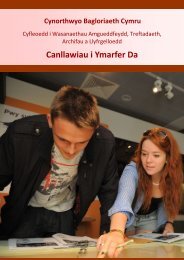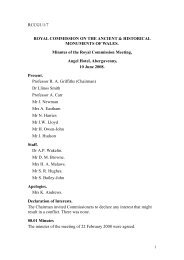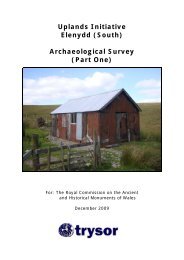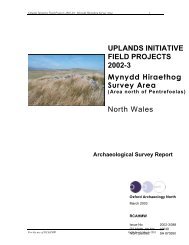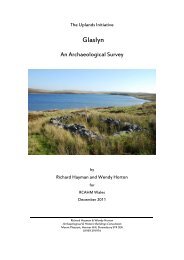Upl<strong>and</strong>s Initiative – Nant y Moch & Pumlim<strong>on</strong> Fawr / <str<strong>on</strong>g>Plynlim<strong>on</strong></str<strong>on</strong>g> 2004THE RING-CAIRN (NPRN: 284056)This proved to be a structure of some interest. It st<strong>and</strong>s <strong>on</strong> an almost level natural platformprojecting from <strong>the</strong> hillside, <strong>and</strong> comm<strong>and</strong>ing clear views up <strong>and</strong> down <strong>the</strong> Rheidol valley <strong>and</strong> up<strong>the</strong> Gamddwr. Before excavati<strong>on</strong> it appeared as a circular grass-grown st<strong>on</strong>y bank with an entranceto <strong>the</strong> south, <strong>and</strong> <strong>the</strong> writer regarded it as ei<strong>the</strong>r an ancient fold or more probably as an early hutfoundati<strong>on</strong>;<strong>the</strong> fact that no st<strong>on</strong>e-built huts are known in this area increased its interest. Excavati<strong>on</strong>showed at <strong>on</strong>ce that <strong>the</strong> mas<strong>on</strong>ry at <strong>the</strong> entrance was little more than piled st<strong>on</strong>e <strong>and</strong> <strong>the</strong> antiquityof <strong>the</strong> structure seemed doubtful, but a trench was cut al<strong>on</strong>g <strong>on</strong>e radius to make sure that <strong>the</strong> ringc<strong>on</strong>tained no evidence for occupati<strong>on</strong>, <strong>and</strong> this revealed <strong>the</strong> top of a 'post-hole' almost at <strong>the</strong> centre.This left <strong>the</strong> excavator with little doubt that <strong>the</strong> structure was a hut, although so poorly built, <strong>and</strong>ra<strong>the</strong>r more than a quarter of <strong>the</strong> site was cleared for detailed examinati<strong>on</strong>; as <strong>the</strong> work was beingd<strong>on</strong>e largely single-h<strong>and</strong>ed, it was intended to investigate this before deciding whe<strong>the</strong>r completeclearance would be needed. The next step was to empty <strong>the</strong> supposed post-hole, <strong>and</strong> at <strong>on</strong>ce <strong>the</strong> rimof a small pot was exposed; it thus became evident that <strong>the</strong> structure was nei<strong>the</strong>r a hut nor a fold,but some form of religious or sepulchral m<strong>on</strong>ument of <strong>the</strong> Br<strong>on</strong>ze Age. Finally, about threequartersof <strong>the</strong> <str<strong>on</strong>g>central</str<strong>on</strong>g> area was examined. A 5 ft. secti<strong>on</strong> was cut through <strong>the</strong> st<strong>on</strong>e ring <strong>on</strong> <strong>the</strong> eastside, <strong>and</strong> <strong>the</strong> surface of <strong>on</strong>e quadrant of it was completely cleared. The site was re-visited in 1975when <strong>the</strong> water was low, but although almost all <strong>the</strong> peat cover was eroded no additi<strong>on</strong>al internal orexternal features were found, <strong>and</strong> <strong>the</strong>re was no c<strong>on</strong>vincing indicati<strong>on</strong> of fur<strong>the</strong>r kerbing.The whole structure was buried in peat; <strong>the</strong> first 7 in. below <strong>the</strong> grass was brown, merging intoabout 3 in. of black peat at <strong>the</strong> bottom but with no sharp divisi<strong>on</strong>; <strong>the</strong>se layers are thinner over <strong>the</strong>st<strong>on</strong>e ring. Beneath, <strong>the</strong> natural soil is a whitish/yellow rock, mostly soft but with harder masses,over which lies 2—3 in. of light greyish brown clay. The surface of this clay was covered with anetwork of mouse burrows, which had led to <strong>the</strong> formati<strong>on</strong> of lines of ir<strong>on</strong> c<strong>on</strong>creti<strong>on</strong>.The structure produced evidence for a fairly elaborate ritual in its c<strong>on</strong>structi<strong>on</strong>, but <strong>the</strong>workmanship throughout was of poor quality. There was no properly built' mas<strong>on</strong>ry, <strong>and</strong> if <strong>the</strong>designers were aiming at regular planning it can <strong>on</strong>ly be said that <strong>the</strong> setting out was d<strong>on</strong>e 'by eye',<strong>and</strong> by some<strong>on</strong>e whose 'eye' was very poor.The st<strong>on</strong>e ring was about 6 ft. or 7 ft. wide, built up to a height of about 18 in. above <strong>the</strong> oldsurface. The external diameter was roughly 43 ft. There was a very rough suggesti<strong>on</strong> of kerbing(outer edges shown thickened <strong>on</strong> plan), ra<strong>the</strong>r less indefinite at <strong>the</strong> outer circumference than at <strong>the</strong>inner. The fill was mostly loose rubble, but with some pieces of clayey material, suggesting thatlumps of turf were also used. Peat had penetrated into <strong>the</strong> voids in <strong>the</strong> upper part of <strong>the</strong> fill, but<strong>the</strong>re was no trace of any under <strong>the</strong> lowest st<strong>on</strong>es, <strong>and</strong> it seems fairly certain that <strong>the</strong>re was little orn<strong>on</strong>e <strong>on</strong> <strong>the</strong> site when <strong>the</strong> structure was built.A flint scraper was found am<strong>on</strong>g rubble just outside <strong>the</strong> bank, in <strong>the</strong> south-east quadrant. Since<strong>the</strong>re were no impermeable layers anywhere <strong>on</strong> <strong>the</strong> site to prevent <strong>the</strong> migrati<strong>on</strong> of pollen, no peatsamples were taken.The way in which <strong>the</strong> st<strong>on</strong>es lay in <strong>the</strong> bank <strong>and</strong> <strong>on</strong> <strong>the</strong> enclosure suggested that <strong>the</strong> builders hadkept off <strong>the</strong> <str<strong>on</strong>g>central</str<strong>on</strong>g> area, so that when st<strong>on</strong>es intended for <strong>the</strong> inner kerb fell out of place <strong>the</strong>y werenot picked up <strong>and</strong> re-set; this, however, is merely a subjective impressi<strong>on</strong>, incapable of proof. On<strong>the</strong> south <strong>the</strong> bank was interrupted by a gap about 5 ft. wide. The west side of this was merely aroughly built-up slope of st<strong>on</strong>es, but <strong>the</strong> east was fairly well defined by a kerb of three large blocks.The gap itself was clear except for a single large slab, about 2 ft. across <strong>and</strong> 6 in. thick. It was tooheavy to have been moved accidentally into this positi<strong>on</strong>, <strong>and</strong> may possibly represent a formalritual blocking of <strong>the</strong> entrance. If so, <strong>the</strong> fact that it does not extend right across <strong>the</strong> entrancepassage would be in, keeping with <strong>the</strong> quality of <strong>the</strong> structure as a whole.71CAP Report No: 355
Upl<strong>and</strong>s Initiative – Nant y Moch & Pumlim<strong>on</strong> Fawr / <str<strong>on</strong>g>Plynlim<strong>on</strong></str<strong>on</strong>g> 2004FIGURE 6. Urn from Aber Camddwr ring cairn (NPRN: 284056).Within <strong>the</strong> ring, <strong>the</strong> <str<strong>on</strong>g>central</str<strong>on</strong>g> space for a diameter of about 12 ft. was almost clear of st<strong>on</strong>es, apartfrom those covering <strong>the</strong> burnt skelet<strong>on</strong> (see below). Outside "this area st<strong>on</strong>es were more frequent,mostly, it appeared, <strong>the</strong> casual scatter natural to <strong>the</strong> surface. In <strong>the</strong> south-east quadrant, however,<strong>the</strong>ir appearance <strong>and</strong> greater frequency suggested deliberate rough pavings, perhaps with a kerbabout 3 in. high in <strong>the</strong> north half, running parallel to <strong>the</strong> inner kerb of <strong>the</strong> bank <strong>and</strong> about 3 ft. fromit. It must be emphasised, though, that <strong>the</strong> st<strong>on</strong>ework is all so rough that it is impossible to be quitecertain whe<strong>the</strong>r minor features of this kind were intenti<strong>on</strong>al. In <strong>the</strong> following account, stake-holesare lettered (A—Z, a—e), larger hollows are numbered (Pits 1-9).The traces of ritual activities were almost c<strong>on</strong>fined to <strong>the</strong> cleared area. Near its centre was a hole(Pit 1) about 1 ft. in diameter <strong>and</strong> of similar depth, tapering slightly towards <strong>the</strong> bottom. Thisc<strong>on</strong>tained a small Collared Urn, <strong>the</strong> surrounding space being filled with black peaty soil c<strong>on</strong>tainingbirch <strong>and</strong> alder charcoal. Near this point was found a bun-shaped lump of white quartzite, similar indiameter to <strong>the</strong> top of <strong>the</strong> pot, which may have formed a cover for it, but apart from this possibility,<strong>the</strong> hole was not sealed in any way, except by <strong>the</strong> peat which had formed over it.At least two dozen stakes had been set upright within <strong>the</strong> ring. One (L) had been driven close to <strong>the</strong>hole <strong>on</strong> its west side <strong>and</strong> ano<strong>the</strong>r (QJ diametrically opposite to it into <strong>the</strong> hole itself, breaking <strong>the</strong>side of <strong>the</strong> pot. The positi<strong>on</strong> of <strong>the</strong> fragments showed that this had been almost full of earth whenburied. The c<strong>on</strong>tents were examined by Dr. I. W. Cornwall, but <strong>the</strong>re was nothing to distinguish<strong>the</strong>m from ordinary soil humus; this does not, of course, exclude <strong>the</strong> possibility that someuncarb<strong>on</strong>ised organic material was present originally. Eight o<strong>the</strong>r hollows (Pits 2-9) had been cutinto <strong>the</strong> floor of <strong>the</strong> enclosure; five of <strong>the</strong>se lay <strong>on</strong> a semicircle of radius 7 ft. with centre 4 ft. southof <strong>the</strong> pot, <strong>and</strong> <strong>the</strong> remaining three close within it. All were bowl-shaped, not post-holes; details ofsize <strong>and</strong> c<strong>on</strong>tents are given in Appendix III, but most of <strong>the</strong>m c<strong>on</strong>tained nothing to indicate whatpart <strong>the</strong>y had played in <strong>the</strong> ritual associated with <strong>the</strong> site.North-west of <strong>the</strong> pot, however, Pits 2, 3 <strong>and</strong> 4 were covered by four large irregular slabs laid flat,with two more resting <strong>on</strong> <strong>the</strong>m. In Pit 2 were <strong>the</strong> remains of a child, which had been incompletelyburned in situ. The b<strong>on</strong>es were too fragmentary to determine age or sex, but before removal it couldbe seen that <strong>the</strong> largest surviving l<strong>on</strong>g-b<strong>on</strong>e (femur ?) had been about 8 in. l<strong>on</strong>g. They rested <strong>on</strong> amass of oak charcoal, suggesting that <strong>the</strong>y had been placed <strong>on</strong> a thick plank or tray; its shape wasnot recoverable, but <strong>the</strong> part which had been fully carb<strong>on</strong>ised suggested a width of about 9 in., witha roughly rounded end. The b<strong>on</strong>es <strong>the</strong>mselves were not in any sort of order, as though <strong>the</strong> body hadbeen completely disarticulated before burning; <strong>the</strong>re was no trace of skull or teeth. Since <strong>the</strong>scraper found outside <strong>the</strong> south-east quadrant has been crackled by heat (see below), <strong>and</strong> <strong>the</strong>re wasno o<strong>the</strong>r fire <strong>on</strong> <strong>the</strong> site, it may have been utilised in some way in this part of <strong>the</strong> cerem<strong>on</strong>y.The b<strong>on</strong>es were restricted to Pit 2, but <strong>the</strong> burnt earth <strong>and</strong> charcoal (all oak) extended over <strong>the</strong>intervening space into Pit 3; both <strong>the</strong>se were very shallow. Pit 4 c<strong>on</strong>tained no charcoal, so waspresumably dug <strong>and</strong> refilled before <strong>the</strong> fire was lit. Fragments of oak <strong>and</strong> hazel charcoal werepresent in <strong>the</strong> filling of Pits 5 <strong>and</strong> 6.71CAP Report No: 355




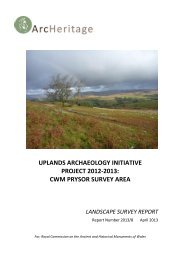
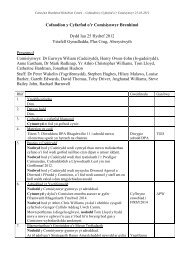
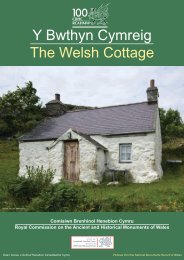

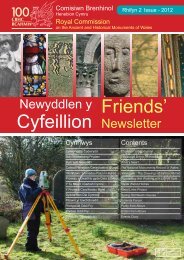
![The Source of the Usk Walk [2012 PDF]](https://img.yumpu.com/49285699/1/190x245/the-source-of-the-usk-walk-2012-pdf.jpg?quality=85)

